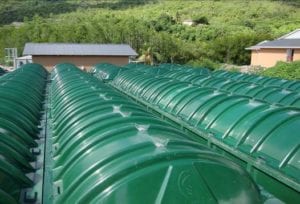Company offers rapid installation, flexible funding model, low operating and maintenance overheads and long term reliability.
Africa will break away from the centralised model of sewage treatment and adopt a decentralised approach that can be deployed rapidly, independent of access to capital, and with low operating and maintenance costs, predicts Loyiso Jiya, chairman of Bannow Africa. In an exclusive interview with Water&Sanitation Africa, Jiya says the delivery of sewage services to communities can be provided in a short time frame and with greatly reduced capital outlay if decision-makers jettison the western notion of centralised treatment. Other developing nations, such as Vietnam, India and Brazil, have taken on the decentralised model with success. “Development in many parts of South Africa and other African countries is being held back because of constraints on access to mains sewage, power and water. What frightens municipalities is the vision of deploying several hundred package sewage plants across a wide geographical area and thereafter having to cope with such plants in various levels of disarray. They prefer to have a centralised treatment plant under their control. “But the risk can be mitigated through the implementation of guarantees on plant reliability, as is required by eThekwini Municipality, and the signing of maintenance contracts to reliable outsourced suppliers,” Jiya states. A possible shift in the current mindset at government level will be achieved by the conduct of a feasibility study by various water and wastewater treatment sector stakeholders, who would look at alternative technologies of wastewater treatment plants, comparing whole life costing of the packaged solution and a large scale municipal system. It is common cause that the latter can take up to five years to design, build and commission at a cost of hundreds of millions of rand, depending on plant capacity. “In terms of our ‘what if’ scenario, we postulate setting up and operating decentralised units on site in numerous locations instead of channelling the sewage for tens of kilometres into a massive central plant at vast expense. ‘What if the treated effluent was made available for irrigation purposes at the various locations rather than using potable water? And what if we are able to meet the required treatment standards consistently for up to 20 years?”Jiya asked. “We say adopt sewage mining: scrap the pipeline, scrap the pump station and put the package plant directly on the location where it taps directly into the existing sewage lines. Discharge the treated material back into the river or use it for irrigation. And with our package plants at even remote locations there is nothing much worth stealing because our units are mostly fibreglass.” “The plant can be used as a short-term solution to support stressed municipal sewage treatment plants, as a long-term solution in areas that need treatment capacity but are not connected to sewerage pipes, or in remote locations where it is not economically viable to install large-scale municipal treatment plants. Jiya pointed out that package plants based on the rotating biological contactor (RBC) design had developed a reputation for poor reliability, which had arisen as a result of bearing failure on the rotating disc shaft that is integral to the design of many such systems. With the internationally patented Blivet system, the effluent flows into a primary settlement tank and then into the heart of the plant, an aerator rotating biological drum. As the drum rotates it lifts the effluent into its coils, effectively aerating the effluent to promote bacteria and biomass growth, which absorb the nutrients. The system is self-regulating, self-oxygenating and powered by a simple electric motor. It was designed in Ireland in 1985 and installed at a housing estate where the local authority was due to build a conventional wastewater treatment works. The package plant has been operating problem free since then.Bannow Export, the manufacturer and supplier of Blivet packaged sewerage plants, entered the South African market last year following a successful visit to this country by a trade delegation from Ireland. Bannow Africa is wholly owned by black South Africans. The board members comprise Jiya, Gerrard Sullivan, Colin Bloom (RGM) and Ted O’Morcoe. Jiya, formerly a senior partner with Ernst & Young, is also a member of the Eastern Cape Development Corporation Board, in a province where the potential for package plants is significant.
A Blivet package plant that has been operating at the Nedbank Olwazini Training Centre in Muldersdrift, Gauteng, for the past eight years has achieved a Green Drop award (92.6% for 2012) and was adjudged the national best performer of four private sector facilities tested. The plant uses a BMS Blivet RBC type activated sludge process and has a treatment capacity of 64 m³/d. Bannow Africa’s first operating units since the company was established in South Africa will be installed at the Cacadu District Municipality in Eastern Cape. At the time of writing the company had quoted on various package treatment plants at 17 different locations in South Africa, Zimbabwe and Zambia. Many Blivet and other package plants installed by Bannow Export in Africa, including South Africa, since 2001, are in use at resorts and other locations. “Initially, we had the same view of our potential growth path in South Africa as did our Irish parent company,” says Jiya. ‘We believed the private sector hospitality industry would be our main market and that business there would drive growth in the public sector. However, the reverse has proven to be true.” Among the issues raised by potential customers in the public sector are financing, speed of installation, capacity, operating requirements and maintenance. Jiya indicates that Bannow Africa has developed three financing models – outright purchase; rental funded by Sasfin Bank and Rentworks with full maintenance; and placement of a unit with recovery of costs based on megalitre of effluent treated. “We are in discussion with various municipalities about the latter model, which will carry a minimum of a five-year agreement. Our intention is to identify a funding organisation to finance this model, such as the Development Bank of Southern Africa.” The Bannow Africa range includes the Blivet range of package plants of varying capacities with the smallest suitable for 10 people, and the largest (the Blivet 4000) with a capacity of 100 m³ of effluent per day. However, by placing the package plants in parallel treatment capacity can be increased ad infinitum. The package plant has a life span of 20 years in normal applications and is sustainable owing to its low requirements for electricity and maintenance. “An integral part of our business plan in Africa is to use local communities for installation work as well as for operation and maintenance,” comments Jiya. “Maintenance is minimal as each package plant has two electric motors and two bearings. The plant can be remotely monitored by radio or satellite and any rises in operational levels can be attended to by trained members of the community. A Blivet 4000 plant with a 100 m³/day capacity requires about 14 kW/d of power and can be run on solar power. Back-up batteries are provided.” Bannow has several different package systems, including a closed system model that does not require mains water but still provides users with flushing toilets, another that incorporates additional units and uses sludge to generate biogas for cooking and lighting purposes, and solutions that include disinfection or sludge drying beds. Bannow has a patented chlorination unit as one of the alternatives for disinfection. Bannow Africa has appointed nine distributors nationwide and has offices in Gauteng and the Eastern Cape. Local manufacture has been brought forward and the company is considering setting up a factory in the East London industrial development zone. Bannow Africa is licensed to operate throughout the continent and has set up a joint venture in Zambia. Nigeria is the next location for a joint venture.







